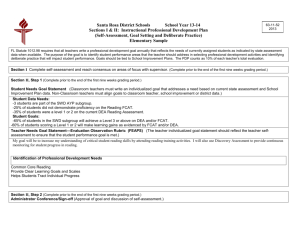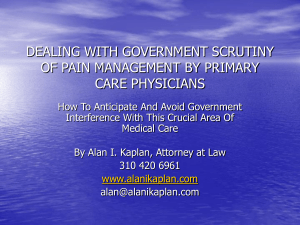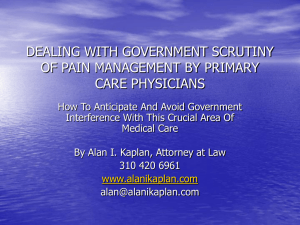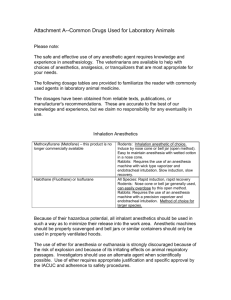May_2011_Newsletter - Doctors for the Environment Australia
advertisement
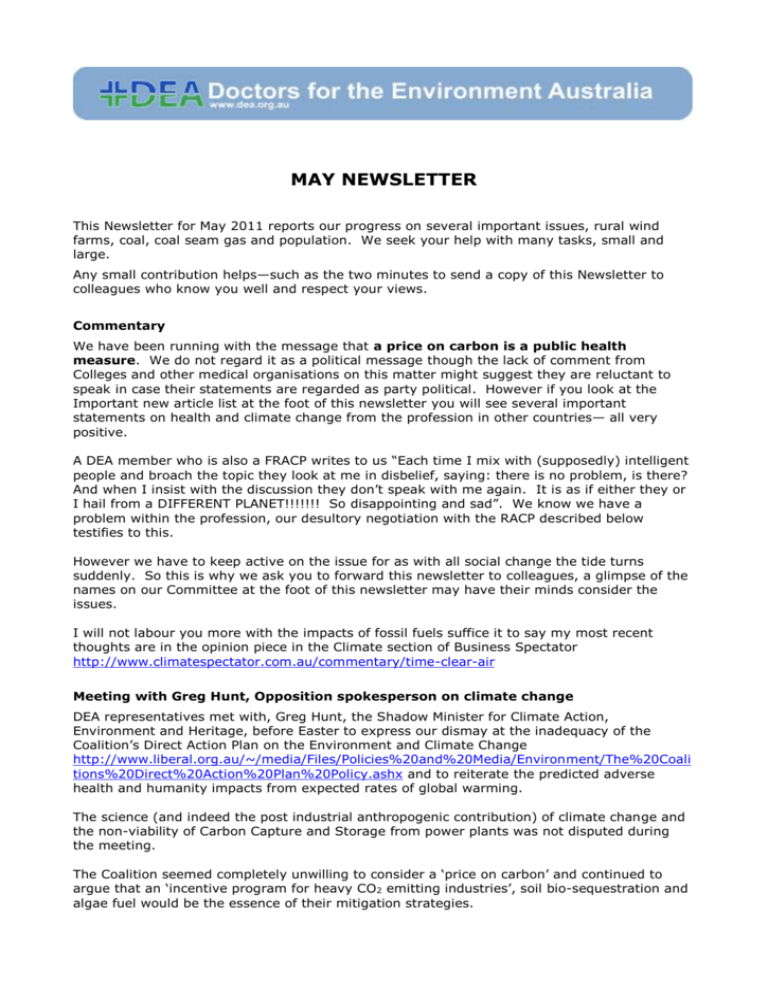
MAY NEWSLETTER This Newsletter for May 2011 reports our progress on several important issues, rural wind farms, coal, coal seam gas and population. We seek your help with many tasks, small and large. Any small contribution helps—such as the two minutes to send a copy of this Newsletter to colleagues who know you well and respect your views. Commentary We have been running with the message that a price on carbon is a public health measure. We do not regard it as a political message though the lack of comment from Colleges and other medical organisations on this matter might suggest they are reluctant to speak in case their statements are regarded as party political. However if you look at the Important new article list at the foot of this newsletter you will see several important statements on health and climate change from the profession in other countries— all very positive. A DEA member who is also a FRACP writes to us “Each time I mix with (supposedly) intelligent people and broach the topic they look at me in disbelief, saying: there is no problem, is there? And when I insist with the discussion they don’t speak with me again. It is as if either they or I hail from a DIFFERENT PLANET!!!!!!! So disappointing and sad”. We know we have a problem within the profession, our desultory negotiation with the RACP described below testifies to this. However we have to keep active on the issue for as with all social change the tide turns suddenly. So this is why we ask you to forward this newsletter to colleagues, a glimpse of the names on our Committee at the foot of this newsletter may have their minds consider the issues. I will not labour you more with the impacts of fossil fuels suffice it to say my most recent thoughts are in the opinion piece in the Climate section of Business Spectator http://www.climatespectator.com.au/commentary/time-clear-air Meeting with Greg Hunt, Opposition spokesperson on climate change DEA representatives met with, Greg Hunt, the Shadow Minister for Climate Action, Environment and Heritage, before Easter to express our dismay at the inadequacy of the Coalition’s Direct Action Plan on the Environment and Climate Change http://www.liberal.org.au/~/media/Files/Policies%20and%20Media/Environment/The%20Coali tions%20Direct%20Action%20Plan%20Policy.ashx and to reiterate the predicted adverse health and humanity impacts from expected rates of global warming. The science (and indeed the post industrial anthropogenic contribution) of climate change and the non-viability of Carbon Capture and Storage from power plants was not disputed during the meeting. The Coalition seemed completely unwilling to consider a ‘price on carbon’ and continued to argue that an ‘incentive program for heavy CO2 emitting industries’, soil bio-sequestration and algae fuel would be the essence of their mitigation strategies. As far as DEA is aware algae fuel is still being developed and not commercially viable on a large scale, soil bio-sequestration of carbon may have some potential but will not mitigate atmospheric CO2 concentrations at the rate or amounts urgently required and incentive programs have no guarantee of success. With regard to their incentive program the Coalition has no inkling of whether the owners of Hazelwood (Australia’s highest CO2 emitting power station) could be enticed to decrease their emissions or not. Preliminary report on DEA student conference in Sydney Delegates to the iDEA 2011 conference in Sydney are returning to their campuses, hospitals, practices and communities with a renewed sense of purpose and passion after a successful two day meeting this past weekend. A mix of inspiring talks, engaging workshops and opportunities to socialise, the conference managed to attract twice the attendees of the inaugural conference of 2009. Locally based students were strongly represented, though there were good numbers from interstate to round things out. Students were also joined by a number of doctor members of DEA, including Management Committee members and interested local practitioners. The weekend got off to a great start with a talk from Dr Linda Selvey speaking about her career progression from public health work through to her current position as head of Greenpeace Australia-Pacific. Dr Selvey was followed by Senator Christine Milne, who urged and challenged doctors and students to embrace their voice as advocates for sustainable political progress. Many other aspects of climate change, energy, consumption and planning were discussed across the day before a Q & A with Honorary Secretary David Shearman. A recurrent theme was the insidious influence of our social, economic and political patterns on health. Panels and speakers enabled delegates to contemplate and reflect on the social, psychological, legal, economic and political impediments and opportunities for transition to a more sustainable and healthy society. This holistic approach was brought into sharp relief with reports back from the Pacific from Associate Professor Ruth Colaguiri and journalist Nic Maclellan. Beyond the academic program, events on Friday and Saturday nights offered a chance for social interaction, reflection and networking. Sunday built on the knowledge and concern established on day one, nurturing optimism and pragmatism as doctors from around Australia reported their local and state efforts to mitigate ill health from environmental degradation. Dr Eugenie Kayak provided an excellent outlook of the potential for hospitals and clinics to reduce their environmental impact, and consequently their negative health impact. Orthopaedic surgeon Mr Matthew Nott rallied energy for local action as he told of incredible community mobilisation and achievement in a rural area. This more uplifting morning with a focus on positive actions was followed by upskilling for the year ahead. Delegates attended workshops in community engagement, political lobbying and strategy before separating into regional groups. The conference closed with well articulated goals for a year of environmental health advocacy, and a new student committee. Rohan Church (Hobart) will be replacing outgoing President Janie Maxwell (Melbourne) as National Student Representative. We farewell Janie from her position with misty eyes and thank her for the dedication and flare that she displayed in the job. DEA warmly welcomes Rohan and his accompanying committee to their new roles. All in all, iDEA 2011 was a thoroughly engaging meeting which will spur us on to great things across the remainder of the year. Details of the new student committee as well as a full synopsis of the conference proceedings will follow over coming weeks. We thank the iDEA 2011 organising committee - Jenny Hellsing, Kitty Soutar, Liz O’Brien, Zoe Wood, Janie Maxwell and Ben Ticehurst - for their efforts and dedication, ensuring the success of the conference. We look forward to the next iDEA conference, for all doctors and medical students, to be held in early 2012. Ben Ticehurst Coal Seam gas campaign Barack Obama has just said about natural gas So we’ve got to make sure that if we’re going to do it, we do it in a way that doesn’t poison people By contrast the Republican’s energy spokesperson on Energy James Inhofe has just said on Fox News There’s never been one case — documented case — of groundwater contamination in the history of the thousands and thousands of hydraulic fracturing. However the facts are The US EPA is preparing a report on clinical problems that have arisen Within the past month, a natural gas well in Bradford County US suffered a blowout with 30,000 gallons of polluted effluent going into the Susquehanna River. Well operator Chesapeake Energy has suspended all hydraulic fracturing operations in Pennsylvania. http://climateprogress.org/2011/04/22/news-chesapeake-suspendsfracking-in-pa-after-blowout-and-leak-contemplating-the-human-cost-of-energy/ Also within the past month, the French government will support parliamentary motions to cancel permits issued for shale gas drilling in order to avoid potential environmental risks, Prime Minister Francois Fillon has said. http://planetark.org/wen/61760 In the US there are reports of abandoned wells continuing to be a health hazard long after their life is completed http://solveclimatenews.com/news/20110407/oil-gas-wellsfracking-drinking-water-pollution-homes?page=show The US House of Representatives Committee on Energy and Commerce has released a report on chemicals used in hydraulic fracking http://democrats.energycommerce.house.gov/sites/default/files/documents/Hydraulic% 20Fracturing%20Report%204.18.11.pdf In Australia during this month CSG contracts for billions of dollars have been signed and several reports have been issued which document the dangers. National Toxics Network has released their report http://ntn.org.au/2011/02/21/call-formoratorium-as-report-finds-fracking-chemicals-have-never-been-tested-for-safety/ and has called for a moratorium The demand for speakers on CSG is growing. Please register your interest in helping. What has DEA done on CSG this month? Coal seam gas: a sleight of hand? The Drumhttp://www.abc.net.au/unleashed/55656.html We are exploring avenues to bring about an enquiry into health aspects of this industry. We cannot say more at this time Campaign against new coal mines The International energy agency (IEA) says– Clean energy technologies are making clear progress globally, but fossil fuels continue to outpace them, mostly because they get far more in subsidies per year; $318 billion in 2010 versus $57 billion for renewables. The IEA says those fossil fuel subsidies need to be removed and governments need to introduce transparent, predictable and adaptive incentives for cleaner, more efficient energy options. http://www.climatespectator.com.au/commentary/clean-out-time What has DEA done on coal this month? Time to clear the air. Climate Spectator http://www.climatespectator.com.au/commentary/time-clear-air If you are not registered for Climate Spectator go to http://dea.org.au/index.php/news/article/time_to_clear_the_air Anglesea coal mine expansion, yet a new frontier for DEA DEA can have an important role in supporting communities to address the health impacts of coal. This is happening in various ways in Queensland and New South Wales. On Saturday April 24th with the Bell's Beach surfing competition just a stone's throw away, over one hundred Anglesea residents gathered to express their concern about the possible health impacts of the extension and expansion of the Anglesea coal mine lease. Local botanist Luke Hynes spoke about the adjoining heritage heath land, engineer Mike Lawrence put forward renewable energy alternatives and Dr Merryn Redenbach spoke on behalf on DEA about the health effects of coal. http://indymedia.org.au/2011/04/23/anglesea-coal-mine-expansion-%E2%80%93-wecan%E2%80%99t-believe-it-either The boundaries of Anglesea mine will be as close as 800m to the new Anglesea Primary School and the smoke stack of the 150MW Anglesea Power station, which produces electricity for Alcoa's Point Henry aluminium smelter, is clearly visible on the same road. The school is located in the "buffer zone" around the mine in which housing construction is not permitted. While the EPA has sulphur dioxide monitoring stations around Anglesea there are no particulate monitoring stations. Research in the health of Anglesea children, or particulate or other pollutant levels around the Anglesea site could be a fantastic BMedSci or advanced training project. Anyone who is interested in undertaking or supervising such research is encouraged to get in touch with DEA. Meanwhile DEA is exploring what can be done to oppose the expansion. More information about the Anglesea extension can be found on the CoalWatch Website: http://www.sourcewatch.org/index.php?title=Anglesea_mine We have written to the Prime Minister, all Ministers and all members Excerpt Doctors for the Environment Australia (DEA) urge both Government and Opposition to resist, on health grounds, carbon tax exemptions for wealthy fossil fuel industries. Indeed we urge government to have these industries pay their way for the ill health they are causing right now in Australian communities through air pollution, as well as their immense contribution to future ill-health resulting from climate change. DEA has drawn attention to the likely health and environmental costs of the coal industry and coal combustion being of the order of $1,000pa for every inhabitant of Australia http://www.thepunch.com.au/articles/big-coal-a-burningissue/?from=scroller&pos=2&link=text. The health impacts have not been properly addressed by state governments and the interests of people should be protected with the institution of a national Health Impact Assessment. The Coal Seam Gas industry also causes significant environmental damage and potential health implications. The National Water Commission has concerns. A new report http://ntn.org.au/wp-content/uploads/2011/04/NTN-Fracking-Briefing-Paper-April-2011.pdf indicates these are considerable and requests a moratorium whilst the safety of chemicals is assessed. Again DEA calls for a national Health Impact Assessment to protect the public health http://www.abc.net.au/unleashed/55656.html. We draw your attention to the fact that the gas industry is quoting green house emission advantages for gas. There is some doubt about this claim in relation to shale gas and we draw your attention to a review in The Hill, US Congress news http://thehill.com/blogs/e2-wire/677e2-wire/155101-report-gas-from-fracking-worse-than-coal-on-climate. These concerns may extend to coal seam gas. We view the demands of the fossil fuel industries as imprudent and against the national interest. It is vital that the cost externalities of their activities are considered along with their claims. Medical Observer and DEA This week the DEA column in Medical Observer is written by Flinders Medical School and DEA student Mani Bergout, Title, Neglect of this patient will affect all of us http://www.medicalobserver.com.au/news/neglect-of-this-patient-will-affect-all-of-us. Well done Mani. We remind student members that we will occasionally put forward other student articles for publication. GM meeting on March 21st convened and Chaired by Bob Phelps of Gene Ethics Gene Ethics, a not for profit organisation campaigns for a sustainable GM-free society, DEA maintains an interest in GM and Dr George Crisp spoke on behalf of DEA about the potential health effects of GM crops and the lack of rigorous testing and health data. Almost 200 people attended the meeting at the Peppermint Grove Library to hear about safety concerns and ethical considerations relating to GM crops. Steve Marsh, a Kojonup farmer, has recently lost his organic certification as a result of contamination with GM canola from a neighbour’s crop, and described his plight, as he is now becoming embroiled in a legal battle with multinational Monsanto. Other speakers including environmental scientist Josh Byrne, Politicians, greens - MLC Lynn McClaren and ALP - MLA Mick Murray, and Concerned Farmers Network's Julie Newman. Please keep us informed about happenings in the GM sphere Editor. Submission to the Senate Community Affairs Committee Inquiry into the Social and Economic Impact of Rural Wind Farms In April we reported DEA has made a submission to the Senate Community Affairs Committee Inquiry into the Social and Economic Impact of Rural Wind Farms. See government’s web site http://www.aph.gov.au/senate/committee/clac_ctte/impact_rural_wind_farms/submissions.ht m (Submission number 829). George Crisp gave evidence to the senate Committee on our behalf. The Hansard transcript is at http://www.aph.gov.au/hansard/senate/commttee/S13730.pdf RACP meeting in Darwin Several Fellows have asked us to arrange a booth at the May 22-25 meeting, as last years’ display at WCIM in Melbourne was so successful. In 2010 the booth cost us $550. We were disappointed to be asked to pay this cost for what we regarded as a core RACP educational activity. Negotiations with the College this year have not produced a satisfactory outcome and we regret that members and fellows will be disappointed. We have been negotiating with the College for a booth since March 9 th and were offered one at $2450+GST which we rejected. We asked for a free table in the Foyer. We have finally been offered a concessional booth rate of $550+GST. We have declined to proceed given the expense; short time-frame available to finalise organisation; and perceived lack of support from the RACP for our contribution to education regarding this public health issue. We call on all DEA Fellows of the RACP, including AFPHM and AFOEM, to consider how we may go ahead in exploring and consolidating partnerships with RACP, including for the 2012 meeting. Increased strength of representation through the RACP Climate Change Working Group may be one option. We note The President’s April statement, “The College is in a strong financial position...” The surplus for 2010 was over $5M. Perhaps WHO’s concerns on climate change could be addressed with a little of this? DEA Annual General Meeting The date of the AGM has been changed to Monday October 17th so that we could be on site in Melbourne for the 'Creating Sustainable Healthy Societies Conference' (further details later) The conference will take place on Saturday 15th and Sunday morning 16th of October. The AGM will be at 5.30 pm on Monday October 17th at Parkville. Please put this date in your diary. Report on Perth Sun Fair at UWA 0n April 10th Dr Janet Roddy organised the DEA stall at this year's Perth Sun Fair. The event was well attended and volunteers, Dr's Nicola Cook, Louise Sparrow, Sue Taylor, Irene Kirczenow, Greg Glazov, and George Crisp were kept busy throughout the day. George Crisp also gave a talk on the health co-benefits from decreasing emissions. DEA and Australian Anaesthesia News (From the DEA Victorian newsletter) Anaesthetist and Victorian DEA representative, Eugenie Kayak, spoke to over 200 anaesthetists at a recent Australian Society of Anaesthetists (ASA) NSW Education Meeting about why health professionals should be acting to improve the environmental impact of their work places and more specifically how ones choice of anaesthetic practice can directly and significantly influence our daily (even weekly) environmental impact. The results of three recent articles that calculate and compare the global warming potentials for routinely used anaesthetic gases were presented and discussed. (Ryan SM, Nielsen CJ. Global warming potential of inhaled anesthetics: application to clinical use. Anesth Analg. 2010 Jul; 111(1):92-8. Sulbaek Andersen MP etal. Inhalation anaesthetics and climate change. Br J Anaesth. 2010 Dec; 105(6): 760-766. Ishizawa Y. General Anesthetic Gases and the Global Environment. Anesth Analg. 2011 Jan; 112(1): 213-7) An anaesthetist’s choice of anaesthetic gas and delivery flow rates for one day can have more influence on daily CO2 emissions than whether one chooses to walk or fly to their next interstate meeting. Visits to members of Parliament DEA will continue to write to and visit sitting members of parliament at both the Federal and State level during this crucial time. We will be calling for a bipartisan approach to the mitigation of CO2 emissions including a price on carbon for the health of our and future generations. We thank those members of DEA who have visited their members of parliament recently and we ask that those who are preparing a visit contact us to obtain previous correspondence with their member and to avail themselves of our latest policy statements. Nuclear medicine in Australia A Joint Health Sector Position Statement on nuclear medicine, requesting an inquiry into the nuclear medicine industry in Australia has been signed by MAPW, the Public Health Association of Australia, Doctors for the Environment Australia, the Australian Nursing and Midwifery Federation (SA) and the Aboriginal Medical Services Alliance (NT). The AMA also supports the call for an inquiry. Overseas practice shows that it is feasible for radioactive isotopes to be supplied through nonreactor sources. The Canadian Government has recently decided to support research and development in expanding non-reactor based isotope production (using particle accelerators) and that the development of a new research reactor could not be justified on the grounds of isotope production. By diversifying the sources of isotope production greater certainty in access to isotopes will be achieved whilst simultaneously reducing the health risks associated with the operation of nuclear research reactors. RECOMMENDATIONS The statement recommends that the inquiry look into both: 1. Radioisotope production 2. Nuclear medicine waste disposal Importantly, it asks that the inquiry to be undertaken before any further actions are taken to advance the construction of a federal radioactive waste dump in Australia. BP excels itself Is there an award for the most insensitive social and environmental action? On the anniversary of BP oil disaster in the Gulf and with many harmed US citizens demonstrating outside BP’s AGM in London, BP has made sizable donations to the Republican party which is fighting stricter rules for offshore drilling and seeking the opening up of Wilderness areas. I have changed my weekly fill up from BP to Woolworths much as I dislike the loss leader approach. Their petrol is Caltex. The other options are all bad! Important new reports on health, environment and climate change Health and the environment: a compilation of evidence http://www.aihw.gov.au/publicationdetail/?id=10737418534&libID=10737418533&tab=2. This compilation of research evidence on how human health can be positively and negatively influenced by the environment has been released today by the Australian Institute of Health and Welfare (AIHW). Excellent report, use as a resource. James Hansen et al conclude “the rate of sea level rise is likely to accelerate during the next several years.” http://climateprogress.org/2011/04/20/hansen-sea-level-risefaustian-aerosol-bargain/print/ Doctors urged to take climate leadership role http://www.guardian.co.uk/environment/2011/apr/05/doctors-climate-changeleadership Climate change is affecting the health of patients — and physicians are starting to see the results American medical Association http://climateprogress.org/2011/04/04/ama-climate-change-is-affecting-the-health-ofpatients-and-physicians-are-starting-to-see-the-results/print/ Clean Air Act delivered $1.3 trillion in health and other benefits in 2010 alone at $53 billion cost. This paper reviews a study from the Union of Concerned Scientists USA http://climateprogress.org/2011/04/14/clean-air-act-benefits-ucs-ticker/print/ Climate change and POPs: Predicting the Impacts (From the Stockholm Convention on persistent Organic pollutants). Excellent and comprehensive report http://chm.pops.int/Programmes/GlobalMonitoringPlan/ClimateChangeandPOPsPredictin gtheImpacts/tabid/1580/language/en-US/Default.aspx Aphekom Report. Improving Knowledge and Communication for decision making on air pollution and health in Europe. Excellent read and lots to learn Editor http://www.endseurope.com/docs/110302b.pdf Have a laugh or a cry column An editorial in Investors Business Daily (USA) on 20/4 Climate change is speculation, not a proven fact, and the case for it has been based on documented fraud coming out of the United Nation's Intergovernmental Panel on Climate Change, Britain's Climate Research Unit and even our own NASA. Data have been manipulated, manufactured and even suppressed to "hide the decline" in global temperatures that have gone up and down in a regular pattern through history, including the centuries preceding the Industrial Revolution. The planet has, in fact, cooled slightly during a period of quiet solar activity. Sea levels are not dangerously rising, the Himalayan glaciers are still there, the rain forests are doing quite well, as are the polar bears. If people are suffering, it is because of the damage being done to their economies by governments in the name of fighting climate change, which is neither imminently dangerous nor man-made. David Shearman Hon Secretary

